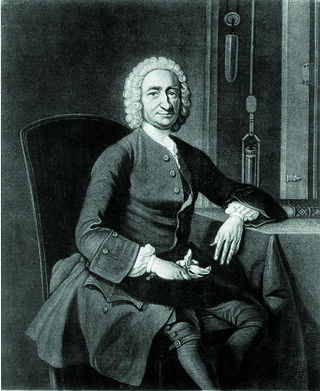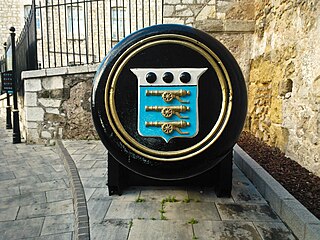
John Flamsteed was an English astronomer and the first Astronomer Royal. His main achievements were the preparation of a 3,000-star catalogue, Catalogus Britannicus, and a star atlas called Atlas Coelestis, both published posthumously. He also made the first recorded observations of Uranus, although he mistakenly catalogued it as a star, and he laid the foundation stone for the Royal Greenwich Observatory.

The Royal Observatory, Greenwich is an observatory situated on a hill in Greenwich Park in south east London, overlooking the River Thames to the north. It played a major role in the history of astronomy and navigation, and because the Prime Meridian passed through it, it gave its name to Greenwich Mean Time, the precursor to today's Coordinated Universal Time (UTC). The ROG has the IAU observatory code of 000, the first in the list. ROG, the National Maritime Museum, the Queen's House and the clipper ship Cutty Sark are collectively designated Royal Museums Greenwich.

Sir Christopher WrenFRS was an English architect, astronomer, mathematician and physicist who was one of the most highly acclaimed architects in the history of England. Known for his work in the English Baroque style, he was accorded responsibility for rebuilding 52 churches in the City of London after the Great Fire in 1666, including what is regarded as his masterpiece, St Paul's Cathedral, on Ludgate Hill, completed in 1710.

George Graham, FRS was an English clockmaker, inventor, and geophysicist, and a Fellow of the Royal Society.

Higham is a village in the Borough of Pendle in Lancashire, England, south of Pendle Hill. The civil parish is named Higham with West Close Booth. The village is 2 miles (3 km) north-east of Padiham and about 4 miles (6 km) south-west of Nelson along the A6068 road.

The Surveyor-General of the Ordnance was a subordinate of the Master-General of the Ordnance and a member of the Board of Ordnance, a British government body, from its constitution in 1597. Appointments to the post were made by the crown under Letters Patent. His duties were to examine the ordnance received to see that it was of good quality. He also came to be responsible for the mapping of fortifications and eventually of all Great Britain, through the Ordnance Survey, and it is this role that is generally associated with surveyor-generalship.

Rear admiral Sir John Berry was an English officer of the Royal Navy.

Major-General John Armstrong was a British military engineer and soldier, who served as Chief Royal Engineer and Surveyor-General of the Ordnance.

Hugh May was an English architect in the period after the Restoration of King Charles II. He worked in the era which fell between the first introduction of Palladianism into England by Inigo Jones, and the full flowering of English Baroque under John Vanbrugh and Nicholas Hawksmoor. His own work was influenced by both Jones' work, and by Dutch architecture. Although May's only surviving works are Eltham Lodge, and the east front, stables and chapel at Cornbury House, his designs were influential. Together with his contemporary, Sir Roger Pratt, May was responsible for introducing and popularising an Anglo-Dutch type of house, which was widely imitated.
Events from the year 1675 in England.
Richard Towneley was an English mathematician, natural philosopher and astronomer, resident at Towneley Hall, near Burnley in Lancashire. His uncle was the antiquarian and mathematician Christopher Towneley (1604–1674).

Sir William Robinson PC(I) was a British architect, military engineer and politician. He held several posts in the Dublin Castle administration, including as Surveyor General of Ireland from 1671 until 1700. He was an influential figure in the development of classical architecture in Ireland, designing many buildings in the English Baroque-style, particularly in Dublin.

Sir Richard Edgcumbe was an English politician.
Sir Martin Beckman (1634/35–1702) was a draughtsman/painter, Swedish-English colonel, chief engineer and master gunner of England.

James Hodgson (1672–1755) was an English astronomer, mathematical teacher, lecturer and writer.
Edward Haynes or Haines was an English astronomer and Fellow of the Royal Society.
Sir Jonas Moore was an English surveyor.
William Englebert, was a noted inventor and engineer in the reign of Queen Elizabeth I. According to Thomas Fuller, he was "an incomparable engineer", and John Norden praised him as "an excellent engineer". Elizabeth I awarded him an annual pension of one hundred marks.












